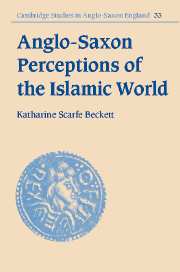Book contents
- Frontmatter
- Contents
- Acknowledgements
- List of abbreviations
- 1 Introduction
- 2 Islam during the Anglo-Saxon period
- 3 Anglo-Saxon contacts with Islam
- 4 Arabs and Arabia in Latin
- 5 Ismaelites and Saracens in Latin
- 6 Arabs, Ismaelites and Saracens in early Anglo-Latin
- 7 Pseudo-Methodius and the sons of Ismael
- 8 Arabs, Ismaelites and Saracens in Old English
- 9 Persisting theories about Saracens in post-Conquest England
- 10 Conclusions
- Bibliography
- Index
2 - Islam during the Anglo-Saxon period
Published online by Cambridge University Press: 22 September 2009
- Frontmatter
- Contents
- Acknowledgements
- List of abbreviations
- 1 Introduction
- 2 Islam during the Anglo-Saxon period
- 3 Anglo-Saxon contacts with Islam
- 4 Arabs and Arabia in Latin
- 5 Ismaelites and Saracens in Latin
- 6 Arabs, Ismaelites and Saracens in early Anglo-Latin
- 7 Pseudo-Methodius and the sons of Ismael
- 8 Arabs, Ismaelites and Saracens in Old English
- 9 Persisting theories about Saracens in post-Conquest England
- 10 Conclusions
- Bibliography
- Index
Summary
Scholarly discussions abound on the inception and expansion of Islamic religion and government, on the development of Muslim schools of thought and relations with other religions and empires, and the flowerings and dissemination of Islamic architecture, astronomy, calligraphy, jurisprudence, literature, mathematics, medicine and philosophy (for example) over the past fourteen centuries. This chapter is based on secondary literature; it is not intended to provide new information nor original insights for historians but only a simple introduction to the religion and territories of Islam during the period 600–1100. The emphasis is on the topics most relevant to Anglo-Saxon perceptions of Arabs and Saracens: first, Islamic conquest and government around the Mediterranean and in north-western Europe and, secondly, some sample early responses by Christian observers who came under Muslim rule. It does not include any account of Muslim culture and government in southern Arabia or further east than present-day Iraq, nor of arts and sciences under Islam. Many eastern Christian accounts and all Jewish responses to the Muslim conquests have been excluded. Despite its limitations, it seemed important to include this partial outline of the history of Islam AD 600–1100 so that subsequent chapters about Anglo-Saxon contacts with Islam and literary representations of Arabs and Muslims might appear in some kind of historical context.
The phrase ‘the history of Islam’ suggests one authoritative account of one monolithic institution. Said has suggested further that no western account of Islam can be separated from interests in authority and power.
- Type
- Chapter
- Information
- Anglo-Saxon Perceptions of the Islamic World , pp. 27 - 43Publisher: Cambridge University PressPrint publication year: 2003

